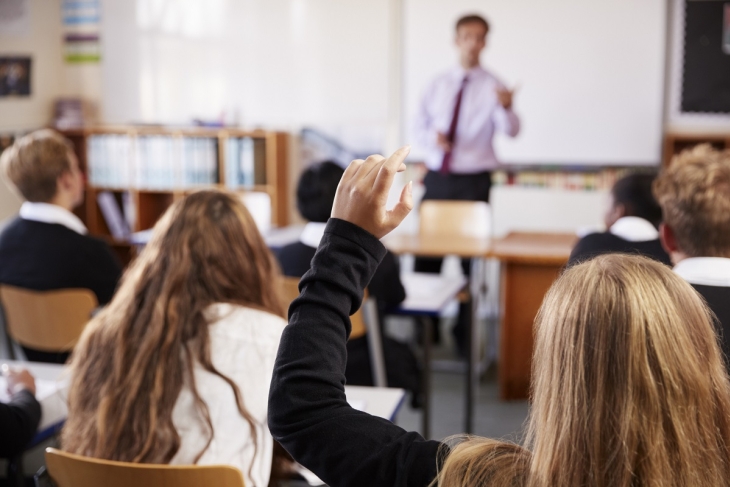As schools across Ohio stagger toward the finish line of a bizarre and difficult school year, educators, parents, and state and local leaders are beginning to turn their attention toward the uncertainties of the future. There are plenty of analyses about how schools will attempt to cope with the fallout of coronavirus. The “brutal math of a massive economic downturn” and the possibility of enrollment shifts seem to be top of mind for both the traditional public and charter school sectors.
But Ohio-specific analyses on how coronavirus might affect private schools are far harder to come by. That’s not surprising, given their small share of the state’s student population. Chartered private schools educate approximately 169,000 students, compared to the 1.5 million children enrolled in traditional public districts, or about 11 percent of the total. Private schools—likely surprising to some—educate a larger share of students than charter schools, which are responsible for educating approximately 103,000 Ohio youngsters. Charter schools tend to draw considerable media and public attention because they are publicly funded and subject to the state’s accountability system, whereas private schools are not. (Their share of enrollment in urban districts is also much higher.) Unless there’s a debate over vouchers, private schools typically fly under the radar.
COVID-19 could change that. Like their traditional district and charter school counterparts, private schools are facing financial stress and enrollment shifts that could alter their operations. But unlike their public peers, private schools aren’t financially backstopped by taxpayer dollars. Instead, most of their funding comes from student tuition, fundraising, and philanthropic support.
In a healthy economy, private schools can more easily rely on tuition and donations. But in the midst of an unprecedented economic crisis, this funding model becomes a liability. In a recent survey of private school employees, 44 percent of respondents said they are “very” or “extremely worried” about drops in philanthropic support. Forty-one percent reported similar levels of concern about collecting tuition for the remainder of the year, as well as the possibility that the crisis would extend into next year. Sixty-five percent of respondents are “very” or “extremely worried” about students’ families struggling financially. And 51 percent are worried about losing enrollment next year.
The recently passed CARES Act offers private schools a few forms of financial reprieve, such as allowing them to participate in the Paycheck Protection Program. But those funds won’t be enough in the long run. Over a million Ohioans have filed for unemployment since the pandemic started. Some families that could previously afford tuition are now dealing with job losses and salary cuts. Even if they can get back to work, many of them will have significant financial holes to dig out of and may be forced to withdraw their children from private schools.
Philanthropy and fundraising could also take a hit. Religious schools that depend on weekly donations are likely suffering after months of cancelled services. Spring fundraising events like festivals and alumni gatherings were cancelled by public health orders, and summer camps and programs may not go on as scheduled. These various funding losses could add up. Many of Ohio’s private schools were already operating on razor-thin margins prior to the pandemic. The fallout of COVID-19 could be the final straw that forces them to close their doors.
A spike in such closures would have a rippling impact across Ohio’s education sector. Obviously, private school students and families will bear the most direct impact. Transferring to a new school is stressful and disruptive in normal circumstances, let alone in the midst of a pandemic. It’s also important to recognize that families don’t enroll in private schools by default; they specifically choose their schools for academic, cultural, religious, and other reasons. Being forced out of these chosen schools due to closure or a sudden inability to pay is a serious loss. The staff and teachers at these schools will also be forced to find new jobs, which is no small feat in the midst of an economic downturn where millions of others are also searching for work.
A sudden influx of transfer students will also cause serious problems for districts and the state. In a recent analysis, ExcelinEd points out that even if a small percentage of private school students return to districts, they could be facing millions of dollars in new costs. Based on average per-pupil expenditures, if only 5 percent of Ohio’s private school students return to district schools in the fall, the fiscal cost to public schools could be over $166 million.
In an ideal world, the state would send additional funds to districts to cover the cost of educating transfer students. But Ohio’s current economic circumstances are far from ideal. K–12 public schools are already facing $300 million worth of cuts. Additional cuts are likely next year. Even if state leaders empty the rainy day fund and the economy miraculously rights itself in record time, Ohio’s current funding system wouldn’t drive additional aid to district schools. The budget Governor DeWine signed into law last summer suspended the state’s funding formula, so Ohio is currently funding schools in accordance with what they received last year, rather than their enrollments. Returning students who were using a performance-based voucher will bring those funds back to districts, but voucher dollars are only a small percentage of the total per-pupil educational cost. For the most part, districts that see an influx of private school students won’t see any additional state aid.
The upshot? A sudden spike in private school closures won’t just hurt the students, families, and staff who attend them. Traditional public schools will pay a hefty price too, and so will the state as it tries to play catch up. There are no easy answers for how lawmakers should address these issues. But seriously considering the negative impacts on students and families—and taking steps to mitigate those impacts where possible—would be a good place to start.


